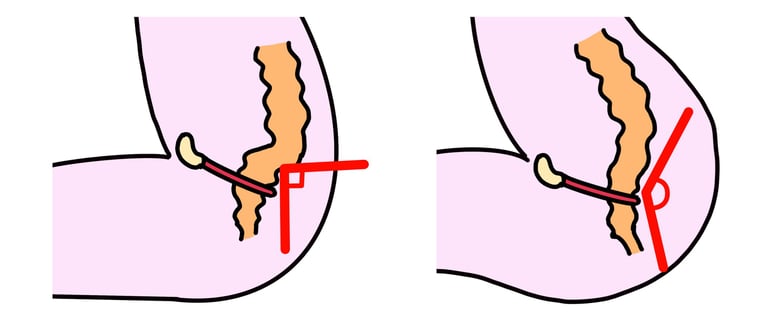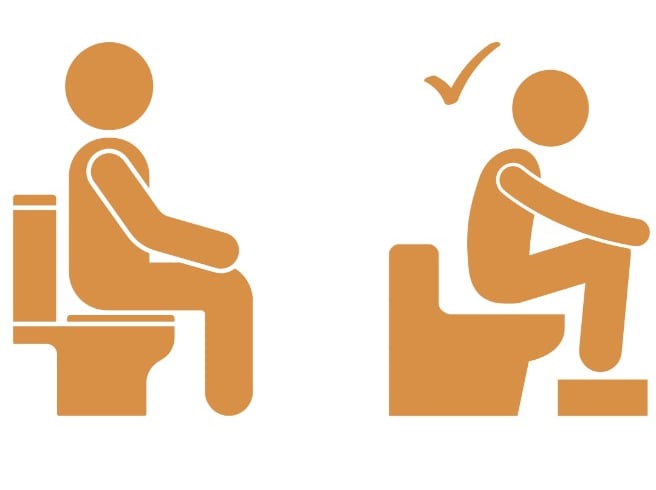
Natural Ways to Help Constipation, Part 2 - Using a Poop Stool
Natural ways to help constipation. Part 2 of our blog series is about how to use a poop stool to ease constipation. Read on to learn how using a toilet-assisted device like a poop stool may help ease your constipation an straining.
5/8/20246 min read
When it comes to relieving constipation and straining during bowel movements, a poop stool can be a game-changer. This simple yet effective tool is designed to help you achieve the optimal position for a more effortless and efficient elimination process.
So how does a poop stool work? Well, it's all about anatomy and the natural alignment of the body. When we sit on a seated toilet our hips are flexed at a 90-degree angle. In this position the rectum, the ‘pipe’ from which our stool exits the body, has a slight bend. This can make it harder for stool to pass through and result in straining and discomfort.
A poop stool on the other hand, elevates your feet and raises your knees above your hips, mimicking a squatting position. This position straightens out the rectum, allowing for a more unobstructed passage of stool. By aligning the body in this way, it may help you to reduce the need to strain and exert excessive pressure during bowel movements.
Not only does using a poop stool help with constipation and straining, but it can also have other positive effects on your overall digestive health. When you squat, the muscles in your abdomen and pelvic floor naturally relax, creating an easier path for waste elimination. This can help prevent issues like haemorrhoids, anal fissures, and even pelvic organ prolapse.
Moreover, using a poop stool can promote more complete and thorough emptying of the bowels. With constipation and straining, we often do not fully evacuate the stool from our rectum, leading to a feeling of incomplete or partial elimination. By adopting the squatting position facilitated by a poop stool, you may find that you are able to empty your bowels more effectively.
It's important to note that using a poop stool is not just for those who suffer from chronic constipation. Even if you have regular bowel movements, incorporating a poop stool into your bathroom routine can help maintain optimal bowel health and prevent any potential issues in the future.
If you find yourself struggling with constipation, incomplete emptying or straining during bowel movements, it may be worth considering investing in a poop stool. This simple and affordable tool may make a world of difference in your digestive health and overall well-being.
The Science of how it works
Before we delve into the research, let's understand a little better how the poop stool actually works and helps easier bowel movements. As mentioned before, traditionally, particularly in western countries, we are accustomed to sitting on a toilet seat at a 90-degree angle, which is not the ideal position for efficient bowel movements. When you sit in this position, the rectum is partially compressed by the puborectalis muscle to help maintain bowel continence. The puborectalis is one of the muscles of the pelvic floor. It creates a sling position around the rectum causing a kink or a bend it the ‘pipe’ so to speak. This is known as the anorectal angle, which is almost at a right angle.
When you engage the use of a poop stool to elevate your feet it creates a position similar to if you would be squatting, by lifting the knees above the hips. By mimicking a natural squat position, the poop stool helps to relax the hold of puborectalis muscle around the rectum, which then allows the rectum or ‘pipe’ to straighten. This straightening is what helps a smoother and more complete evacuation of stool, helped along by gravity.
What the research says
Several studies have been conducted to investigate the effects of squatting on bowel movements. One study published in the journal Digestive Diseases and Sciences, looked at three different positions while having a bowel movement. The study compared sitting on a 16-inch-high standard toilet, a 12-inch-high lower toilet, and squatting. The study found that squatting resulted in significantly reduced time to have a bowel movement with subjects also reporting increased sensation in the rectum and less straining compared to the seated positions (1).
Another study published in the Journal of Clinical Gastroenterology found that using a defecation posture modification device such as a Squatty Potty stool, improved the efficiency of bowel movements by shortening the time it took to empty the bowels. The subject cohort in this study consisted of healthy individuals, up to half of whom struggled with straining and incomplete emptying, and with over half reporting small amounts of blood on the tissue paper on occasion. The results of the study showed that when using the Squatty Potty device there was improvement in bowel movement duration, less straining and the feeling of more complete bowel movements (2).
A third study published in the Journal of the American Board of Family Medicine evaluated reviews of individuals who purchased a toilet stool on Amazon over a period of 6 and a half years. The comments were from the purchase of 19 different stools and the number of comments evaluated were over 10,000. The researchers looked at perceived effectiveness, overall satisfaction and potential side effects of using the toilet stool. The research suggested that 8 out 9 people who used a stool found it highly effective and satisfactory (3). However, there are some limitations with such a study. The researchers did point out that not everyone buying a stool would leave a review and it may not always be clear that every purchase would be for constipation use. However, the research suggest further studies are warranted to evaluate whether using devices that create squat like position aid better and easier bowel movements and reduce constipation.
Overall, the research on poop stools is promising suggesting that using toilet assisted devices to mimic a squat position may be effective in promoting more efficient and comfortable bowel movements. By facilitating a squatting position, these devices help to relax the pelvic floor, in particular the hold of the puborectalis around the rectum allowing for easier passage of stool. This not only reduces the time and effort required for defecation and more complete feelings of emptiness, but also minimizes the need for straining, which may potentially lead to various complications. Poop stools offer a simple yet effective solution for improving bowel health and overall well-being.
Other potential benefits of using a poop stool
It may reduce the risk of diverticulosis. Diverticulosis is a condition characterized by the formation of small pouches in the colon wall. These pouches can become inflamed and infected, leading to a more serious condition called diverticulitis. It is reported that diverticulosis is more prevalent in western countries due to a high processed, low fibre diet that contributes to constipation and straining issues. Western countries also use seated toilets while other countries with less incidence of diverticulosis use squat toilets. This may also be a contributor to the problem for reasons we talked about previously.
It may reduce risk of Pelvic Organ Prolapse. Pelvic organ prolapse is a condition in which the organs in the pelvic area, such as the bladder, uterus, or rectum, descend into the vaginal canal. This can cause discomfort, urinary incontinence, and other symptoms. Due to poop stools reducing the need to strain there may be reduced risk of pelvic organ prolapse.
Enhances Overall Well-being. Quality of life is often affected in individuals who experience regular constipation. If using a poop stool can help to alleviate constipation and other associated symptoms then quality of life will potentially improve. When we feel comfortable and regular in our bowel movements, we experience less discomfort, bloating, and other digestive symptoms, leading to greater quality of life.
References
1. Sakakibara R, Tsunoyama K, Hosoi H, Takahashi O, Sugiyama M, Kishi M, Ogawa E, Terada H, Uchiyama T, Yamanishi T. Influence of Body Position on Defecation in Humans. Low Urin Tract Symptoms. 2010 Apr;2(1):16-21. doi: 10.1111/j.1757-5672.2009.00057.x. Epub 2010 Jan 11. PMID: 26676214.
2. Modi RM, Hinton A, Pinkhas D, Groce R, Meyer MM, Balasubramanian G, Levine E, Stanich PP. Implementation of a Defecation Posture Modification Device: Impact on Bowel Movement Patterns in Healthy Subjects. J Clin Gastroenterol. 2019 Mar;53(3):216-219. doi: 10.1097/MCG.0000000000001143. PMID: 30346317; PMCID: PMC6382038.
3. Sebo P, Quinio C, Viry M, Haller DM, Maisonneuve H. Perceived Effectiveness and Overall Satisfaction of Using a Toilet Stool to Prevent or Treat Constipation: An Analysis of Online Comments. J Am Board Fam Med. 2022 Jul-Aug;35(4):836-839. doi: 10.3122/jabfm.2022.04.210474. PMID: 35896469.




Contact
The Body Project
Level 4,6 Help Street
Chatswood
NSW, 2067
(02) 9884 8758
fiona@topazhealth.au
Quick Links
FAQs
Osteopathy for Gut Health
Osteopathy for TMJ
Fees
Resources
Copyright © 2024 | Topaz Health | Privacy Policy | ABN: 141 202 953 15


Blues Point Practice
117 Blues Point Road
North Sydney
NSW, 2060
0422713396
You Little Beauty
Shop 7, 33 Tramore Place
Killarney Heights
NSW, 2087
0422713396
